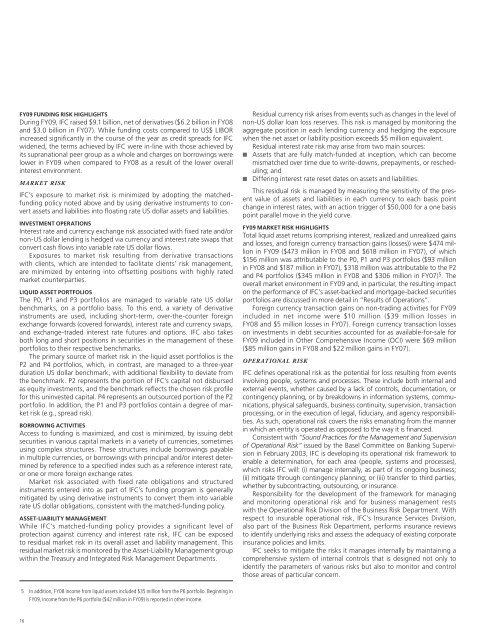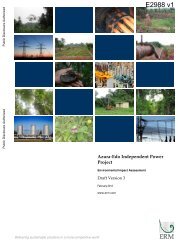Volume 2 - IFC
Volume 2 - IFC
Volume 2 - IFC
You also want an ePaper? Increase the reach of your titles
YUMPU automatically turns print PDFs into web optimized ePapers that Google loves.
FY09 FUNDING RISK HIGHLIGHTS<br />
During FY09, <strong>IFC</strong> raised $9.1 billion, net of derivatives ($6.2 billion in FY08<br />
and $3.0 billion in FY07). While funding costs compared to US$ LIBOR<br />
increased significantly in the course of the year as credit spreads for <strong>IFC</strong><br />
widened, the terms achieved by <strong>IFC</strong> were in-line with those achieved by<br />
its supranational peer group as a whole and charges on borrowings were<br />
lower in FY09 when compared to FY08 as a result of the lower overall<br />
interest environment.<br />
MARKET RISK<br />
<strong>IFC</strong>’s exposure to market risk is minimized by adopting the matchedfunding<br />
policy noted above and by using derivative instruments to convert<br />
assets and liabilities into floating rate US dollar assets and liabilities.<br />
INVESTMENT OPERATIONS<br />
Interest rate and currency exchange risk associated with fixed rate and/or<br />
non-US dollar lending is hedged via currency and interest rate swaps that<br />
convert cash flows into variable rate US dollar flows.<br />
Exposures to market risk resulting from derivative transactions<br />
with clients, which are intended to facilitate clients’ risk management,<br />
are minimized by entering into offsetting positions with highly rated<br />
market counterparties.<br />
LIQUID ASSET PORTFOLIOS<br />
The P0, P1 and P3 portfolios are managed to variable rate US dollar<br />
benchmarks, on a portfolio basis. To this end, a variety of derivative<br />
instruments are used, including short-term, over-the-counter foreign<br />
exchange forwards (covered forwards), interest rate and currency swaps,<br />
and exchange-traded interest rate futures and options. <strong>IFC</strong> also takes<br />
both long and short positions in securities in the management of these<br />
portfolios to their respective benchmarks.<br />
The primary source of market risk in the liquid asset portfolios is the<br />
P2 and P4 portfolios, which, in contrast, are managed to a three-year<br />
duration US dollar benchmark, with additional flexibility to deviate from<br />
the benchmark. P2 represents the portion of <strong>IFC</strong>’s capital not disbursed<br />
as equity investments, and the benchmark reflects the chosen risk profile<br />
for this uninvested capital. P4 represents an outsourced portion of the P2<br />
portfolio. In addition, the P1 and P3 portfolios contain a degree of market<br />
risk (e.g., spread risk).<br />
BORROWING ACTIVITIES<br />
Access to funding is maximized, and cost is minimized, by issuing debt<br />
securities in various capital markets in a variety of currencies, sometimes<br />
using complex structures. These structures include borrowings payable<br />
in multiple currencies, or borrowings with principal and/or interest determined<br />
by reference to a specified index such as a reference interest rate,<br />
or one or more foreign exchange rates.<br />
Market risk associated with fixed rate obligations and structured<br />
instruments entered into as part of <strong>IFC</strong>’s funding program is generally<br />
mitigated by using derivative instruments to convert them into variable<br />
rate US dollar obligations, consistent with the matched-funding policy.<br />
ASSET-LIABILITY MANAGEMENT<br />
While <strong>IFC</strong>’s matched-funding policy provides a significant level of<br />
protection against currency and interest rate risk, <strong>IFC</strong> can be exposed<br />
to residual market risk in its overall asset and liability management. This<br />
residual market risk is monitored by the Asset-Liability Management group<br />
within the Treasury and Integrated Risk Management Departments.<br />
Residual currency risk arises from events such as changes in the level of<br />
non-US dollar loan loss reserves. This risk is managed by monitoring the<br />
aggregate position in each lending currency and hedging the exposure<br />
when the net asset or liability position exceeds $5 million equivalent.<br />
Residual interest rate risk may arise from two main sources:<br />
■ Assets that are fully match-funded at inception, which can become<br />
mismatched over time due to write-downs, prepayments, or rescheduling;<br />
and<br />
■ Differing interest rate reset dates on assets and liabilities.<br />
This residual risk is managed by measuring the sensitivity of the present<br />
value of assets and liabilities in each currency to each basis point<br />
change in interest rates, with an action trigger of $50,000 for a one basis<br />
point parallel move in the yield curve.<br />
FY09 MARKET RISK HIGHLIGHTS<br />
Total liquid asset returns (comprising interest, realized and unrealized gains<br />
and losses, and foreign currency transaction gains (losses)) were $474 million<br />
in FY09 ($473 million in FY08 and $618 million in FY07), of which<br />
$156 million was attributable to the P0, P1 and P3 portfolios ($93 million<br />
in FY08 and $187 million in FY07), $318 million was attributable to the P2<br />
and P4 portfolios ($345 million in FY08 and $306 million in FY07) 5 . The<br />
overall market environment in FY09 and, in particular, the resulting impact<br />
on the performance of <strong>IFC</strong>’s asset-backed and mortgage- backed securities<br />
portfolios are discussed in more detail in “Results of Operations”.<br />
Foreign currency transaction gains on non-trading activities for FY09<br />
included in net income were $10 million ($39 million losses in<br />
FY08 and $5 million losses in FY07). Foreign currency transaction losses<br />
on investments in debt securities accounted for as available-for-sale for<br />
FY09 included in Other Comprehensive Income (OCI) were $69 million<br />
($85 million gains in FY08 and $22 million gains in FY07).<br />
OPERATIONAL RISK<br />
<strong>IFC</strong> defines operational risk as the potential for loss resulting from events<br />
involving people, systems and processes. These include both internal and<br />
external events, whether caused by a lack of controls, documentation, or<br />
contingency planning, or by breakdowns in information systems, communications,<br />
physical safeguards, business continuity, supervision, transaction<br />
processing, or in the execution of legal, fiduciary, and agency responsibilities.<br />
As such, operational risk covers the risks emanating from the manner<br />
in which an entity is operated as opposed to the way it is financed.<br />
Consistent with “Sound Practices for the Management and Supervision<br />
of Operational Risk” issued by the Basel Committee on Banking Supervision<br />
in February 2003, <strong>IFC</strong> is developing its operational risk framework to<br />
enable a determination, for each area (people, systems and processes),<br />
which risks <strong>IFC</strong> will: (i) manage internally, as part of its ongoing business;<br />
(ii) mitigate through contingency planning; or (iii) transfer to third parties,<br />
whether by subcontracting, outsourcing, or insurance.<br />
Responsibility for the development of the framework for managing<br />
and monitoring operational risk and for business management rests<br />
with the Operational Risk Division of the Business Risk Department. With<br />
respect to insurable operational risk, <strong>IFC</strong>’s Insurance Services Division,<br />
also part of the Business Risk Department, performs insurance reviews<br />
to identify underlying risks and assess the adequacy of existing corporate<br />
insurance policies and limits.<br />
<strong>IFC</strong> seeks to mitigate the risks it manages internally by maintaining a<br />
comprehensive system of internal controls that is designed not only to<br />
identify the parameters of various risks but also to monitor and control<br />
those areas of particular concern.<br />
5 In addition, FY08 income from liquid assets included $35 million from the P6 portfolio. Beginning in<br />
FY09, income from the P6 portfolio ($42 million in FY09) is reported in other income.<br />
16
















